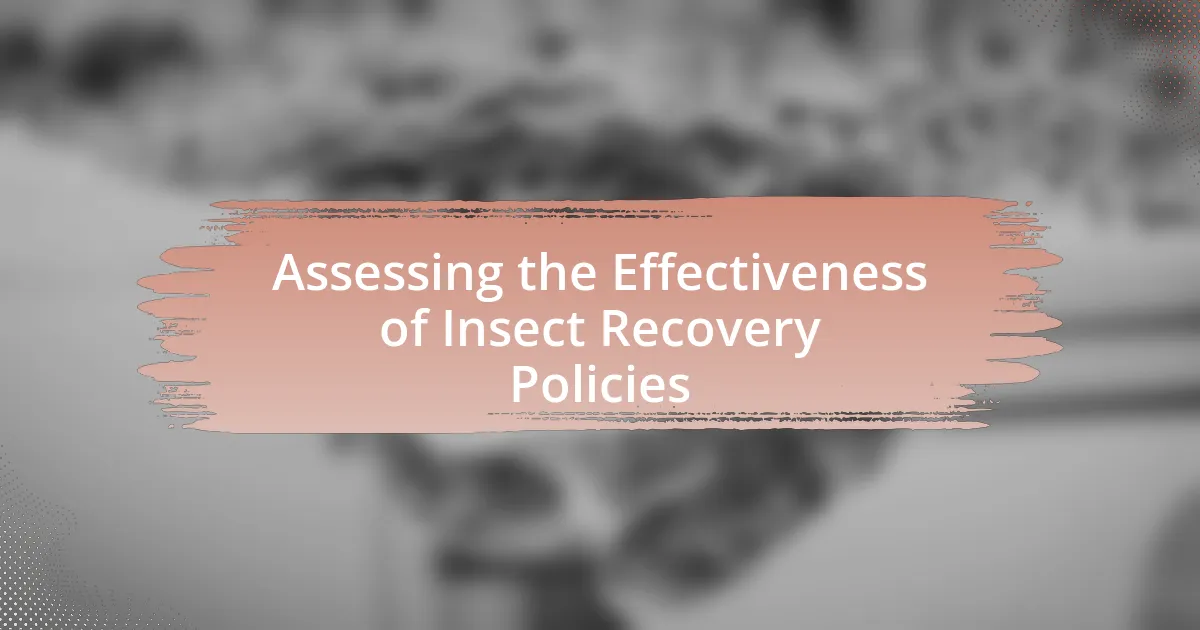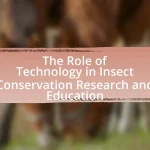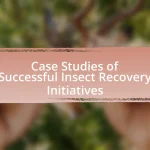Insect Recovery Policies are regulatory frameworks aimed at protecting and restoring declining insect populations through measures such as habitat conservation, pesticide regulation, and research funding. The article examines the effectiveness of these policies by assessing their strategies, regional variations, and the role of insects in ecosystems. It highlights the importance of these policies for biodiversity, the challenges in evaluating their success, and the outcomes observed in various regions. Additionally, it discusses best practices for enhancing policy effectiveness, the significance of stakeholder engagement, and future directions for insect recovery initiatives.
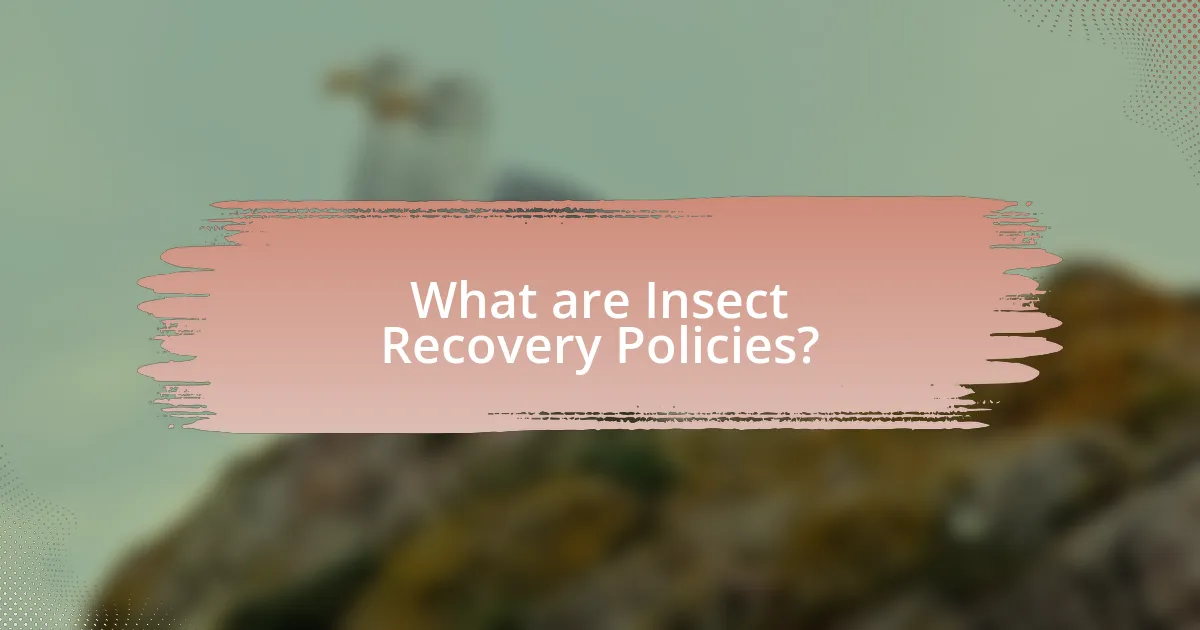
What are Insect Recovery Policies?
Insect Recovery Policies are regulatory frameworks designed to protect and restore declining insect populations. These policies often include measures such as habitat conservation, pesticide regulation, and funding for research on insect ecology and conservation strategies. For instance, the European Union’s Biodiversity Strategy aims to reverse the decline of pollinators by implementing specific actions to enhance their habitats and reduce pesticide use. Such policies are crucial as they address the alarming trends of insect population declines, which have significant implications for ecosystems and agriculture.
How do Insect Recovery Policies aim to restore insect populations?
Insect Recovery Policies aim to restore insect populations by implementing targeted conservation strategies that address habitat loss, pesticide use, and climate change. These policies often include the establishment of protected areas, restoration of native vegetation, and promotion of sustainable agricultural practices. For instance, the European Union’s Biodiversity Strategy for 2030 emphasizes the need to protect and restore ecosystems, which is crucial for supporting diverse insect populations. Additionally, studies have shown that reducing pesticide application can lead to significant increases in pollinator populations, demonstrating the effectiveness of these policies in reversing population declines.
What specific strategies are included in these policies?
The specific strategies included in insect recovery policies typically encompass habitat restoration, pesticide regulation, and public awareness campaigns. Habitat restoration aims to rehabilitate ecosystems that support insect populations, while pesticide regulation seeks to minimize harmful chemical use that adversely affects insects. Public awareness campaigns educate communities about the importance of insects and encourage practices that support their recovery. These strategies are validated by studies showing that habitat restoration can lead to increased insect diversity and abundance, and that reduced pesticide use correlates with healthier insect populations.
How do these strategies vary by region or ecosystem?
Insect recovery strategies vary significantly by region and ecosystem due to differences in biodiversity, climate, and human impact. For example, in temperate regions, strategies often focus on habitat restoration and pesticide regulation, as seen in the European Union’s Biodiversity Strategy, which aims to restore 25,000 km of rivers by 2030. In contrast, tropical ecosystems may prioritize sustainable agricultural practices to combat deforestation and habitat loss, as highlighted by the UN’s Food and Agriculture Organization, which reports that sustainable practices can increase insect populations by up to 30%. These regional differences reflect the unique ecological challenges and conservation needs specific to each area.
Why are Insect Recovery Policies important for biodiversity?
Insect Recovery Policies are crucial for biodiversity because they aim to restore and protect insect populations, which are essential for ecosystem functioning. Insects play key roles in pollination, nutrient cycling, and serving as food sources for other wildlife. For instance, studies show that approximately 75% of global food crops depend on insect pollination, highlighting their importance in maintaining agricultural biodiversity and food security. Furthermore, the decline of insect populations has been linked to broader biodiversity loss, as seen in research published in the journal “Biological Conservation,” which indicates that insect declines can lead to cascading effects on plant and animal communities. Therefore, effective Insect Recovery Policies are vital for sustaining biodiversity and ecosystem health.
What role do insects play in ecosystems?
Insects play a crucial role in ecosystems by serving as pollinators, decomposers, and a food source for other organisms. Pollination by insects, such as bees and butterflies, is essential for the reproduction of many flowering plants, contributing to biodiversity and food production; for instance, it is estimated that one-third of the food consumed by humans relies on insect pollination. As decomposers, insects break down organic matter, recycling nutrients back into the soil, which supports plant growth and maintains soil health. Additionally, insects are a vital food source for birds, mammals, and other wildlife, forming an integral part of the food web. Their decline can disrupt these ecological functions, highlighting the importance of effective insect recovery policies to sustain ecosystem health.
How does the decline of insect populations impact other species?
The decline of insect populations significantly impacts other species by disrupting food webs and pollination processes. Many birds, mammals, and amphibians rely on insects as a primary food source; for instance, studies show that a reduction in insect availability can lead to decreased reproductive success in bird populations, as seen in the decline of certain songbird species in Europe. Additionally, insects play a crucial role in pollinating plants, with approximately 75% of flowering plants relying on animal pollinators, including insects. The loss of these pollinators can result in reduced plant diversity and productivity, which further affects herbivores and the entire ecosystem. Thus, the decline of insects has cascading effects on biodiversity and ecosystem health.
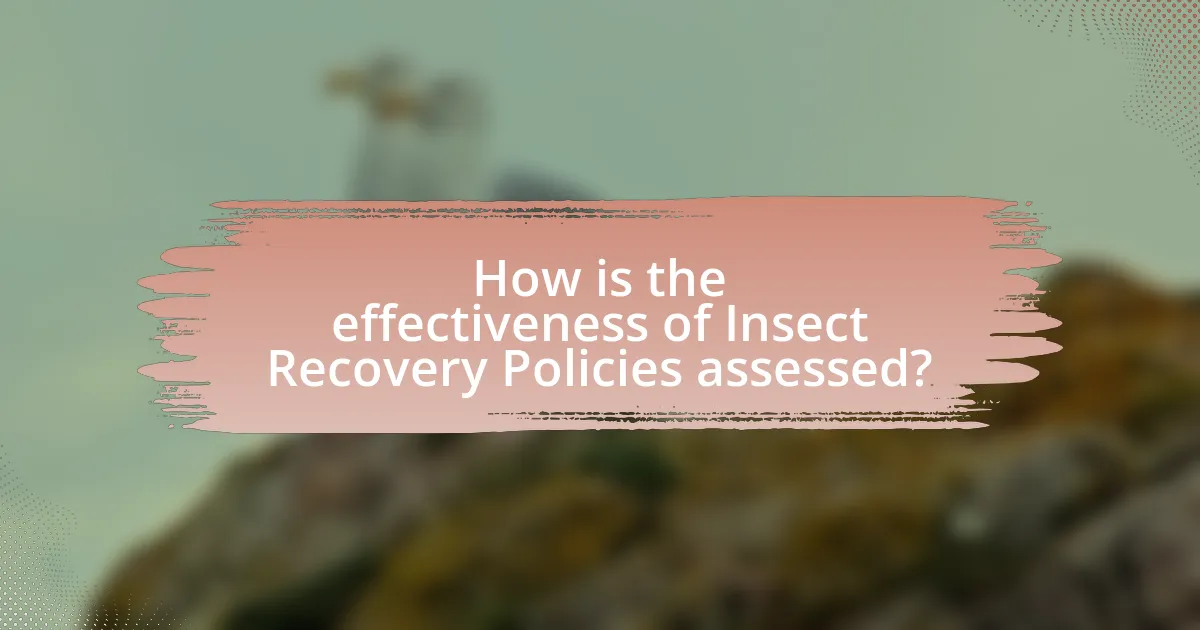
How is the effectiveness of Insect Recovery Policies assessed?
The effectiveness of Insect Recovery Policies is assessed through a combination of monitoring insect populations, evaluating habitat restoration efforts, and analyzing ecological impacts. Monitoring involves systematic data collection on insect abundance and diversity over time, often using standardized survey methods to ensure comparability. Evaluating habitat restoration includes assessing changes in land use, vegetation structure, and availability of resources critical for insect survival. Analyzing ecological impacts focuses on the role of insects in ecosystem functions, such as pollination and nutrient cycling, which can be measured through indicators like crop yields and plant reproduction rates. These assessment methods provide concrete evidence of policy effectiveness, enabling adjustments to improve outcomes for insect populations.
What metrics are used to evaluate the success of these policies?
Metrics used to evaluate the success of insect recovery policies include population density, species diversity, habitat quality, and ecosystem services. Population density measures the number of individuals within a specific area, indicating recovery progress. Species diversity assesses the variety of species present, reflecting ecosystem health and resilience. Habitat quality evaluates the conditions necessary for species survival and reproduction, while ecosystem services quantify the benefits provided by insects, such as pollination and pest control. These metrics collectively provide a comprehensive assessment of policy effectiveness in promoting insect recovery.
How do researchers measure changes in insect populations?
Researchers measure changes in insect populations primarily through methods such as field surveys, trapping, and genetic analysis. Field surveys involve systematically counting and identifying insects in specific habitats over time, allowing for the assessment of population dynamics. Trapping methods, including pitfall traps and light traps, capture insects to provide quantitative data on their abundance and diversity. Genetic analysis can reveal population structure and changes in genetic diversity, which are critical for understanding population health. These methods are supported by studies, such as the one published in “Ecological Entomology,” which highlights the effectiveness of these techniques in monitoring insect populations and assessing ecological impacts.
What indicators reflect the health of ecosystems influenced by insects?
Indicators that reflect the health of ecosystems influenced by insects include species diversity, population abundance, and the presence of key functional groups. Species diversity indicates the variety of insect species present, which contributes to ecosystem resilience and stability. Population abundance measures the number of individuals within a species, providing insight into the health of that species and its role in the ecosystem. The presence of key functional groups, such as pollinators and decomposers, highlights the ecological functions that insects perform, which are essential for processes like plant reproduction and nutrient cycling. These indicators are supported by research showing that ecosystems with higher insect diversity and abundance tend to exhibit greater overall health and functionality.
What challenges exist in assessing the effectiveness of these policies?
Assessing the effectiveness of insect recovery policies faces several challenges, primarily due to the complexity of ecological systems and the variability of insect populations. One significant challenge is the difficulty in establishing clear, measurable indicators of success, as insect populations can fluctuate due to numerous environmental factors unrelated to policy interventions. Additionally, the long time frames required to observe meaningful changes in insect populations complicate assessments, as immediate results may not reflect the long-term impacts of policies. Furthermore, data collection can be inconsistent, with variations in methodologies across studies leading to difficulties in comparing results. For instance, a study published in “Ecological Applications” by D. S. Wilcove and colleagues highlights the importance of standardized monitoring protocols to improve the reliability of effectiveness assessments.
How do external factors complicate the evaluation process?
External factors complicate the evaluation process of insect recovery policies by introducing variables that can skew results and interpretations. For instance, environmental changes such as climate fluctuations can affect insect populations independently of policy effectiveness, making it difficult to attribute changes directly to the implemented policies. Additionally, socio-economic factors, such as land use changes and agricultural practices, can further complicate evaluations by influencing insect habitats and behaviors. Studies have shown that these external influences can lead to misleading conclusions if not adequately controlled for, highlighting the necessity for comprehensive methodologies that account for such variables in the evaluation process.
What limitations do researchers face in data collection?
Researchers face several limitations in data collection, including access to reliable data sources, funding constraints, and methodological challenges. Access to reliable data can be hindered by geographic, legal, or logistical barriers, making it difficult to obtain comprehensive datasets. Funding constraints often limit the scope and scale of research projects, restricting the ability to gather extensive data. Methodological challenges, such as biases in sampling or difficulties in measuring complex ecological interactions, can further complicate data collection efforts. These limitations can significantly impact the quality and applicability of research findings in assessing the effectiveness of insect recovery policies.
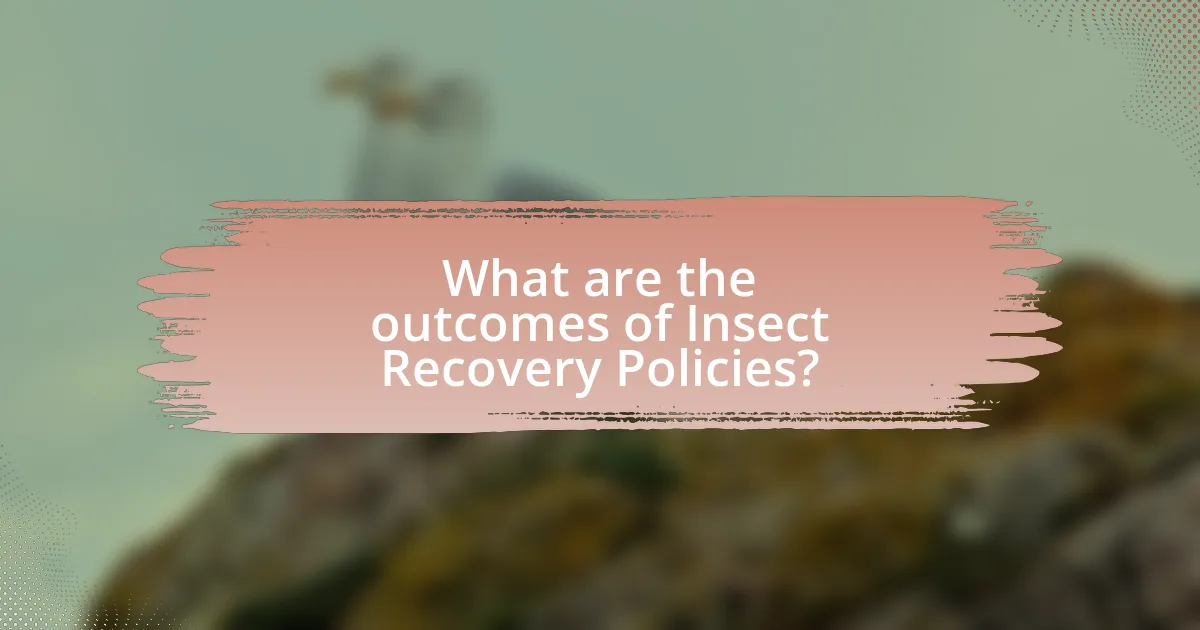
What are the outcomes of Insect Recovery Policies?
Insect Recovery Policies lead to increased insect populations, improved biodiversity, and enhanced ecosystem services. These policies often result in the restoration of habitats, which is crucial for the survival of various insect species. For instance, studies have shown that regions implementing targeted recovery strategies, such as habitat restoration and pesticide regulation, have observed a significant rebound in pollinator populations, which are essential for agricultural productivity and ecological balance. Additionally, the European Union’s Biodiversity Strategy has reported a 20% increase in certain insect populations in areas where recovery policies were actively enforced, demonstrating the effectiveness of such initiatives in reversing insect decline.
How have specific policies succeeded or failed in different regions?
Specific insect recovery policies have succeeded in regions like the European Union, where the Biodiversity Strategy for 2030 aims to restore ecosystems and protect pollinators, resulting in increased populations of certain insect species. Conversely, in regions like North America, policies such as the Endangered Species Act have faced challenges due to insufficient funding and political opposition, leading to limited recovery of at-risk insect populations. For example, the decline of the Monarch butterfly has continued despite protections, highlighting the failure of existing policies to address habitat loss effectively.
What case studies illustrate successful insect recovery efforts?
Successful insect recovery efforts are illustrated by the case studies of the Monarch butterfly in North America and the restoration of the European wild bee populations. The Monarch butterfly population has seen a resurgence due to habitat restoration initiatives, including the planting of milkweed and native flowering plants, which are crucial for their lifecycle. According to the Center for Pollinator Research at Penn State University, these efforts have led to a significant increase in Monarch sightings, with a reported 144% rise in the eastern population from 2014 to 2019.
Similarly, the European wild bee populations have benefited from targeted conservation strategies, such as the establishment of pollinator-friendly habitats and the reduction of pesticide use. Research published in the journal “Nature” by Potts et al. (2010) indicates that these measures have resulted in a recovery of bee diversity and abundance in several regions across Europe, demonstrating the effectiveness of policy-driven recovery efforts.
What lessons can be learned from unsuccessful policies?
Unsuccessful policies reveal critical lessons about the importance of evidence-based decision-making and stakeholder engagement. For instance, the failure of certain insect recovery initiatives often stems from a lack of scientific data to inform strategies, leading to ineffective measures that do not address the root causes of decline. Additionally, policies that do not involve local communities or stakeholders frequently encounter resistance and lack the necessary support for implementation. Historical examples, such as the decline of pollinator populations despite various recovery efforts, highlight the need for adaptive management approaches that incorporate ongoing monitoring and flexibility to adjust strategies based on real-time feedback. These insights underscore the necessity of integrating scientific research and community involvement to enhance the effectiveness of future insect recovery policies.
What best practices can enhance the effectiveness of Insect Recovery Policies?
Best practices that can enhance the effectiveness of Insect Recovery Policies include implementing habitat restoration, promoting biodiversity, and engaging local communities in conservation efforts. Habitat restoration, such as reforestation and wetland rehabilitation, directly supports insect populations by providing essential resources and environments for breeding and feeding. Promoting biodiversity through the protection of various plant and animal species creates a balanced ecosystem that benefits insects, as diverse habitats are crucial for their survival. Engaging local communities fosters stewardship and awareness, leading to more sustainable practices and support for recovery initiatives. These practices are supported by studies indicating that habitat loss and degradation are primary drivers of insect decline, emphasizing the need for targeted recovery strategies.
How can stakeholder engagement improve policy outcomes?
Stakeholder engagement can improve policy outcomes by ensuring that diverse perspectives and expertise are incorporated into the decision-making process. This inclusion leads to more informed policies that address the needs and concerns of all affected parties, ultimately enhancing the effectiveness and acceptance of the policies. For instance, research shows that policies developed with stakeholder input are more likely to achieve their intended goals, as they reflect a broader understanding of the ecological, social, and economic contexts involved. A study by the National Academy of Sciences found that stakeholder engagement in environmental policy leads to better compliance and more sustainable outcomes, demonstrating the tangible benefits of collaborative approaches in policy formulation.
What role does public awareness play in supporting recovery efforts?
Public awareness plays a crucial role in supporting recovery efforts by fostering community engagement and encouraging proactive conservation actions. Increased public knowledge about the importance of insect biodiversity and the threats they face can lead to greater public support for recovery initiatives, such as habitat restoration and sustainable practices. For instance, studies have shown that communities with higher levels of awareness about local insect populations are more likely to participate in conservation programs, which can significantly enhance the effectiveness of recovery policies.
What future directions should Insect Recovery Policies take?
Insect Recovery Policies should prioritize habitat restoration, integrated pest management, and public awareness initiatives. Habitat restoration is essential as it directly addresses the loss of biodiversity and provides the necessary environments for insect populations to thrive. For instance, the decline of pollinators has been linked to habitat loss, with studies indicating that restoring native vegetation can significantly enhance pollinator diversity and abundance. Integrated pest management strategies should focus on reducing chemical pesticide use, which has been shown to negatively impact non-target insect species, thereby promoting healthier ecosystems. Additionally, increasing public awareness about the importance of insects can foster community involvement in conservation efforts, as evidenced by successful campaigns that have led to increased local support for insect-friendly practices. These directions are supported by research indicating that comprehensive approaches combining ecological restoration, sustainable agricultural practices, and education yield the best outcomes for insect recovery.
How can emerging research inform policy adjustments?
Emerging research can inform policy adjustments by providing data-driven insights that highlight the effectiveness or shortcomings of existing insect recovery strategies. For instance, studies such as “Insect Declines and the Role of Conservation” published in the journal Biological Conservation demonstrate that specific habitat restoration efforts significantly enhance insect populations. This evidence can lead policymakers to prioritize funding and resources toward successful conservation methods, thereby optimizing the impact of recovery policies. Additionally, ongoing research can identify new threats to insect populations, prompting timely policy revisions to address these challenges effectively.
What innovative approaches could be integrated into future policies?
Innovative approaches that could be integrated into future insect recovery policies include the implementation of biodiversity corridors and the use of citizen science initiatives. Biodiversity corridors facilitate the movement of insect populations between fragmented habitats, enhancing genetic diversity and resilience, as evidenced by studies showing increased species survival rates in connected ecosystems. Citizen science initiatives engage the public in monitoring insect populations, providing valuable data for policymakers while fostering community awareness and involvement, which has been shown to improve conservation outcomes.
